Subject: Royal Wedding Group.
Image displayed at:
|
||||||||||||||||||||||
| Sitters: (left to right) |
||||||||||||||||||||||
 |
Queen Alexandra (1844-1925), née Princess Alexandra (Caroline Marie Charlotte Louise Julie) of Denmark. | |||||||||||||||||||||
 |
Queen Louise of Denmark (1817-1898), née Louise (Wilhelmine Friederike Caroline Auguste Julie) of Hesse-Cassel. | |||||||||||||||||||||
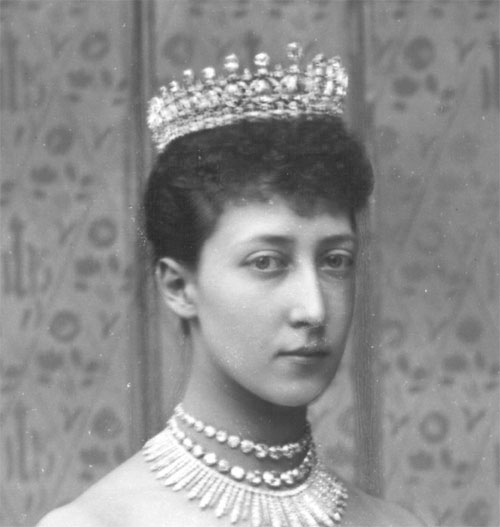 |
Princess Royal, Duchess of Fife (1867-1931) née Princess Louise (Victoria Alexandra Dagmar) of Wales. | |||||||||||||||||||||
| Date: 6th July 1893. Occasion: The Wedding of King George V and Queen Mary, 6th July 1893. Location: Buckingham Palace. Descr: Full length standing. Costume: Court Dress.
Costume suppliers: - Jewellery: |
||||||||||||||||||||||
| (Duchess of Fife) | ||||||||||||||||||||||
|
|
tiara of brilliant, rose-cut and large pear-shaped diamonds [see: Tiaras: A History of Splendour, Geoffrey C Munn, London, 2001, plate 103, The Royal Collection, © Her Majesty Queen Elizabeth II] |
 |
||||||||||||||||||||
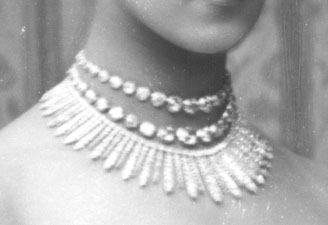 |
diamond fringe necklace [adaptable as tiara], Hancock & Co., CK c. 1889 (wedding gift from her parents, King Edward VII and Queen Alexandra), | |||||||||||||||||||||
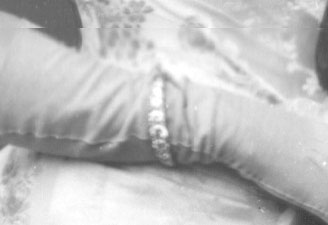 |
half hoop diamond bracelet, Messrs Carrington & Co., c. 1889 (wedding gift from the 'Wives of Cabinet Ministers'). | |||||||||||||||||||||
| (Queen Louise) jewellery descriptions have been kindly provided by Bjarne Steen Jensen | ||||||||||||||||||||||
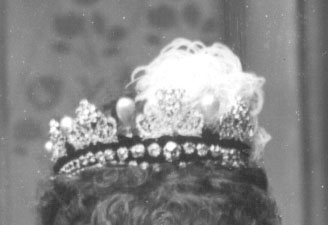 |
"The tiara Queen Louise is wearing belongs to her personal collection. It could be mounted without the large pear shaped pearls. It looks as if it is not a real tiara and I am not sure about that. She had the tiara when she was young so I should think that it comes from her mother Landgravine Louise Charlotte of Hesse, born Princess of Denmark. When her mother died her jewelry was parted into as many parts as she had daughters and she stated in her will that her son, Landgrave Friedrich, should not have any of her personal jewelry. I guess that he inherited jewelry belonging to the house. The earrings seem to be pearl drops. They also are part of her private collection."
|
 |
||||||||||||||||||||
|
"Above the sash
at the decolleté there is a brooch that also belongs to the Danish
crown jewelry: a brooch made of rubies, diamonds and pearls. The |
"Around
her neck the Queen is wearing a dogcollar or more precisely a velvet ribbon
with diamond jewelry on it. It has been mentioned that the jewels should
be some flower bouquets from the Danish crown jewels but is not. It is diamond
pieces from her personal collection. The necklace is a brillant necklace belonging to the Danish crown jewels that can be seen at the Rosenborg Palace in Copenhagen. It was made by the jewellers Weishaupt und Söhne in Hanau, Germany, in 1840. The stones already belonged to the Danish royal family for years and they had been part of the other pieces of jewelry in the family. So was the square cut diamond in the middle of the necklace (17 carats) once set in a ring that was given as a wedding ring from King Christian VII to his unfortunate queen Caroline Mathilde, born a Princess of Great Britain. The pear shaped diamonds (the biggest in the middle is 19 carats) had all been used in aigrettes for earlier queens. Most of the stones were given by Queen Sophie Magdalene to the crown and they are the basis in the Crown jewel collection. The necklace has
a matching set of earrings but they are not used as so by the Queen in
this photo. You can see them though as brooches on the dress along the
sash of the Russian St. Katharina's Order. There are 2 more brooches at
the line of the sash and those two must also belong to her |
|||||||||||||||||||||
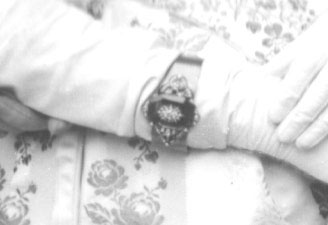 |
amethyst bracelet with diamond centre and broad gold band, John Turner, 58 & 59 New Bond St. c. 1863, (wedding favour from King Edward VII to his mother-in-law). | |||||||||||||||||||||
| (Queen Alexandra) | ||||||||||||||||||||||
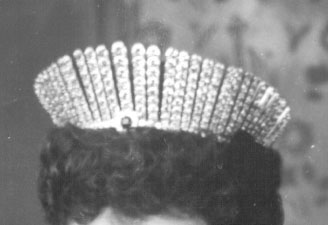 |
diamond fringe tiara, Garrard & Co., 1888, (Silver Wedding gift from the 'Ladies of Society') |
 |
||||||||||||||||||||
| Leslie
Field, The Queen's Jewels, London1987, p 45 Queen Alexandra's Russian Kokoshnik Tiara - Princess Alexandra [upon receiving the tiara in 1888 from Lady Marlborough on behalf of 365 peeresses of the United Kingdom] had specially requested that the tiara be in the fashionable Russian style of a peasant girl's headdress, the Kokoshnik design she knew well from her visits to her sister, the Empress of Russia, who had an identical one. The tiara was made by Garrard, supervised by the Marchionesses of Ailesbury and Salisbury and the Countesses of Cork and Spencer. It is formed of sixty-one platinum bars graduating from the centre in the eighteenth-century manner and totally encrusted with 488 diamonds, of which the two biggest are 3.25 carats each. |
||||||||||||||||||||||
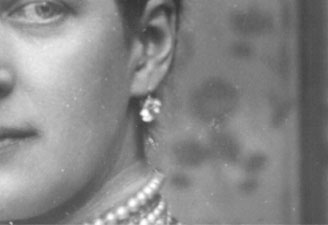 |
diamond earrings [tops only], Garrard & Co., c. 1863, (wedding gifts from the Corporation of the City of London) | |||||||||||||||||||||
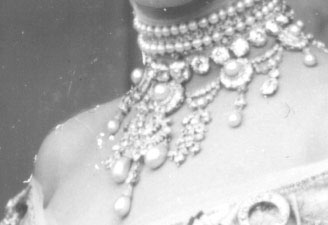 |
dog-collar edged with pearls; diamond rivière; diamond & pearl festoon necklace [with additional pendant jewels] Leslie Field, p 45 |
|||||||||||||||||||||
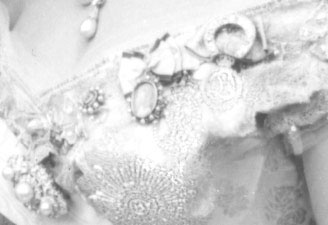 |
diamond & pearl brooch, Garrard & Co., c. 1863, (wedding gifts from King Edward VII); inscribed horseshoe brooch; serpent bangle Leslie Field, p 45 |
|||||||||||||||||||||
|
Furnishings and Props: Gothic style backdrop with the ecclesiastical motif I.H.S. flanked by roses . Photographer: James Stack Lauder (1853-1923), trading as 'J. Lafayette', 30 Westmoreland St., Dublin. (See additional information). Evidence of the studio at work: Several items worn by Queen Alexandra, e.g. the badge of the Imperial Order of the Crown of India, have been partially erased from the negative. No of poses: 1 [but see also neg. nos (D)(00417 & 00423)]. Note: An extant contact
sheet from a display album shows an image of Queen Louise which appears
to be a cropped version of the group photograph seen above: Copyright: V&A All images on this site are copyright V&A. For further information on using or requesting copies of any images please contact the V&A Picture Library: vaimages@vam.ac.uk including the URL of the relevant page Provenance: Pinewood Studios; acquired 1989. Note:
Illustrated London News, 3 September 1897, p 329 - detail showing the clutter of studio photographs in the Amalienborg Palace. References: Biog: Dictionary of National Biography; Hugh Montgomery-Massingberd ed., Burke's Royal Families of the World, Vol 1, London, 1977. Costume: (Queen Alexandra) The Court Journal, 8 July 1893, p 1216; The Gentlewoman, 15 July 1893, pp 77b, 78c & 79a; (Queen Louise of Denmark) The Court Journal, 8 July 1893, p 1216. Jewellery: (Queen Alexandra) Illustrated London News, 7 March 1863, p 239c & 21 March 1863 pp 298 & 325; Sir William Howard Russell, A Memorial of the Marriage of HRH Albert Edward Prince of Wales and HRH Alexandra Princess of Denmark: The Various Events and Bridal Gifts, illustrated by Robert Dudley, 1864; Leslie Field, The Queen's Jewels, London, 1987, pp 44-45; Suzy Menkes, The Royal Jewels, London, 1988 pp 30 & 46-7; Shirley Bury, Jewellery 1789-1910: The International Era, Vol II, London, 1991, pp 501, 503, 504, 507, 603 & 606. (Queen Louise) Illustrated London News, 21 March 1863, pp 321 & 338a. (Duchess of Fife) Illustrated London News, 31 July 1889 pp 6 & 7; The Lady, 1 August 1889, p 119. Location & Photog: Copyright Records, Public Record Office, Kew, COPY 1/413, 14 July 1893, (1 pose registered). Reproduced: The Gentlewoman, 22 July 1893, p 103; Madame, 7 December 1895, p 769. NB: Also published, cropped, as a cabinet card:
Additional Information: Two firms, W. & D. Downey of 61, Ebury St. London, and Lafayette of Dublin, were invited to take official portraits after the marriage ceremony of King George V. An almost identical image, was registered for copyright by W. & D. Downey. Refs: (Downey) The Times, 6 July 1893, p 7a; Public Record Office, Kew, COPY 1/413, 9 September 1893. Much of the jewellery descriptions have been kindly provided by Bjarne Steen Jensen
|
||||||||||||||||||||||